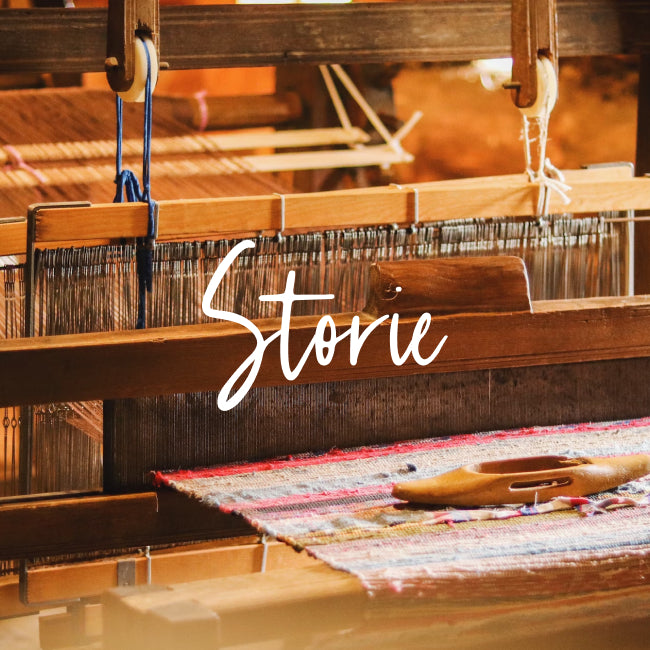Once the daily chores are done, a different type of work begins.
In homes across rural West Bengal, India and neighbouring Bangladesh, women delicately decorate repurposed saris with a simple running stitch, a technique and textile known as Kantha; transforming each piece of used fabric into a piece of art, and a piece of craft heritage. The creators of these beautiful textiles, carefully and skilfully stitch together stories in cloth.

Kantha throws are made to give a second life to a treasured sari : if these garments have stains, tears or other signs of an earlier life, the owner of the sari will sell on the cloth to be repurposed, or she will begin work on the material herself.

A kantha can be simple, joining together several vintage saris in a joyful cocktail of colours; but often the work is far more elaborate, with magnificent patterns and pictures sewn using the kantha running stitch, telling the story of dreams, local myths and legends, poetry and love stories.

Whether the work is simple or complex a kantha is made for everyday use around the house, as a blanket, a floor covering, or to wrap up and protect precious objects.
This is a skill learnt in childhood by women across rural West Bengal, Orissa in India and Bangladesh, which has been practised for generations. It is one of the of the oldest forms of embroidery from the region, and can be traced back to the pre-Vedic age (before 1500 BC).
Many of the women that make this craft did not have the opportunity to go to school, traditionally they would stay at home and look after children. Today kantha making offers these women an opportunity of empowerment through financial independence in areas where it is difficult for them to find paid work.

In the past it was practiced by women of all rural classes; both the rich landlord’s wife and a tenant farmer’s wife would spend their spare time nimbly working on these intricate textiles. Kanthas were not commissioned, but passed down in teaching and gifted from mother to daughter.
In the last century, a complicated mixture of social and political changes meant that fewer and fewer women were making kanthas, and this cultural heritage was really at risk, however, towards the end of the 20th Century a movement began to save this dying folk art.
One of the advocates for the promotion and protection the kantha in India is Shamlu Dudeja, Founder of SHE (Self Help Enterprise), her work aims to reinvent this ancient craft, helping it evolve to become a luxury product.

She says the inspiration for the Kantha starts in nature, with the work of the taylor bird, “ when he needed a nest he would put two leaves together, and with his long beak he would pluck something from the tree and sew the two leaves together.… early men did this too, and using the same stitch, old fabrics tailored together…. (later) village women would wear cotton saris… they would take 3 saris, place them together, and using this running stitch to hold them together. The 3 layers would make the rugs warm, they were often used for babies, and in winter. For baby skin old used cotton is softer than new cotton.”
Today SHE works with over 1000 women, divided in to 6 working groups. Highly skilled team leaders train other women, passing on their knowledge, saving this tradition and in turn giving the women a chance to gain financial independence. When Shamlu set up the group in 1976 there were only 5 women involved; as the movement has grown, so has the appreciation for the skill, and the list of clients, within India and beyond.
Shamlu Dudeja says the projects she has worked on has not only given rural women an income, it’s given them a new perspective and pride in their craft.

Each piece is one of a kind. These textiles cannot be mass produced, and they were never originally made for the marketplace. The craft is a charming marriage of thrift and individual aesthetic, and the small irregularities in the stitching are a reminder of the textile’s unique history. Today, the women who are reinventing and revaluing precious savior faire are crucial to it’s survival. By supporting artisans, and showcasing this skill, Storie hopes to be part of the movement to protect and pass on this craft heritage and it’s creators.
Sources
*Interview with Shamlu Dudeja from Harvard Business school
https://www.hbs.edu/creating-emerging-markets/interviews/Pages/profile.aspx?profile=sdudeja
*SHE Foundation
*West Bengal Rural Craft Hub
*Kantha, Recycled and Embroidered Textiles of Bengal. Radius Books
* Interview with Nawshin Khair, Creative and Managing Director of Aranya Crafts.














